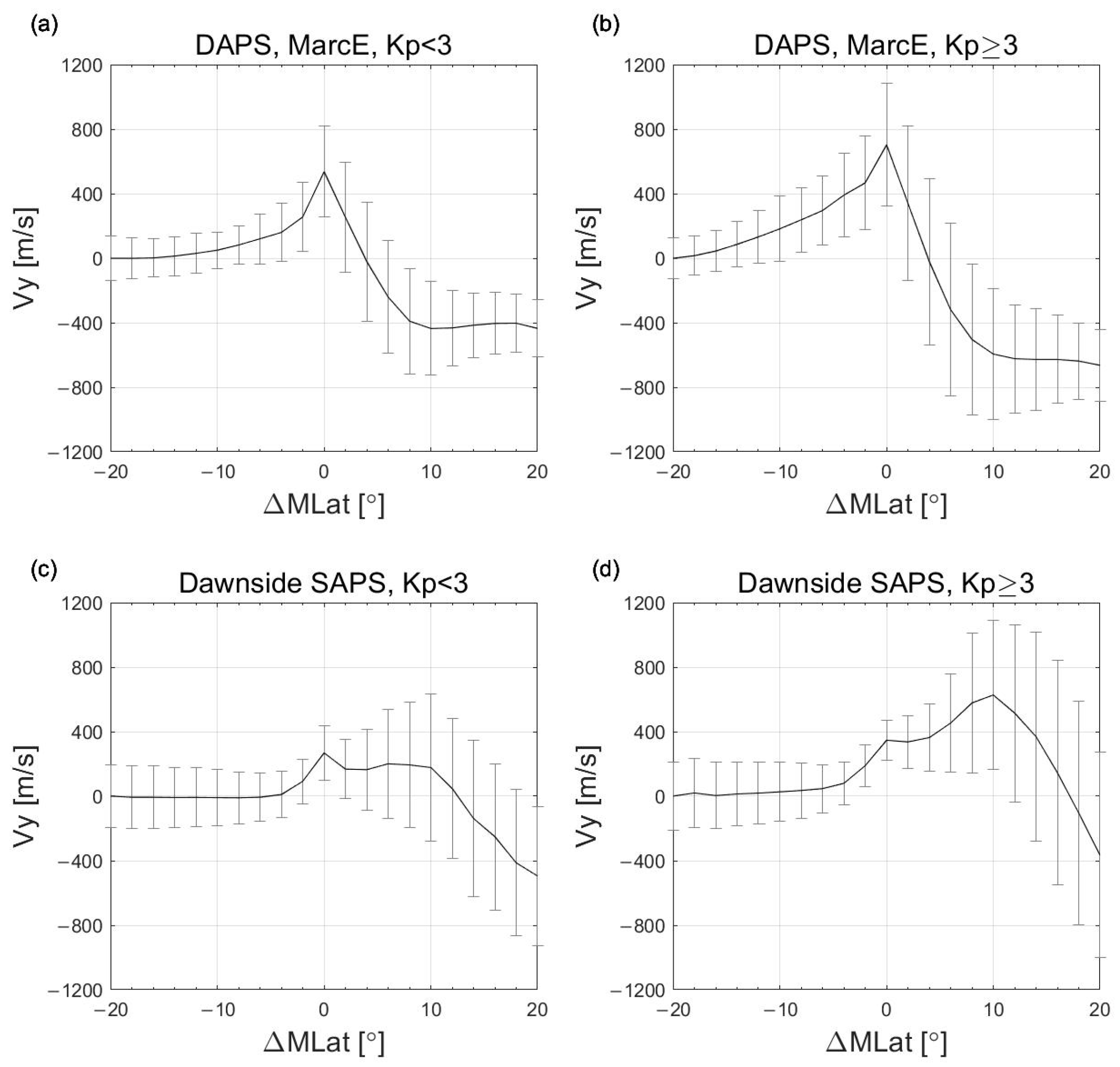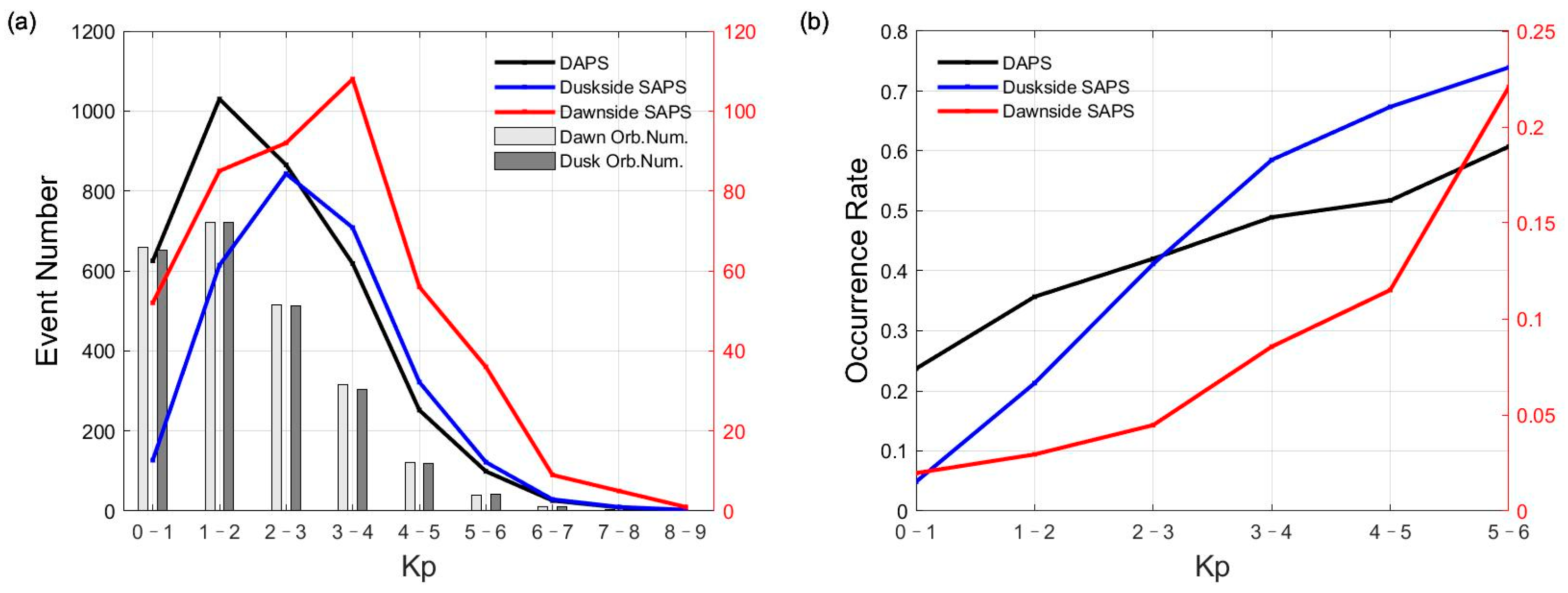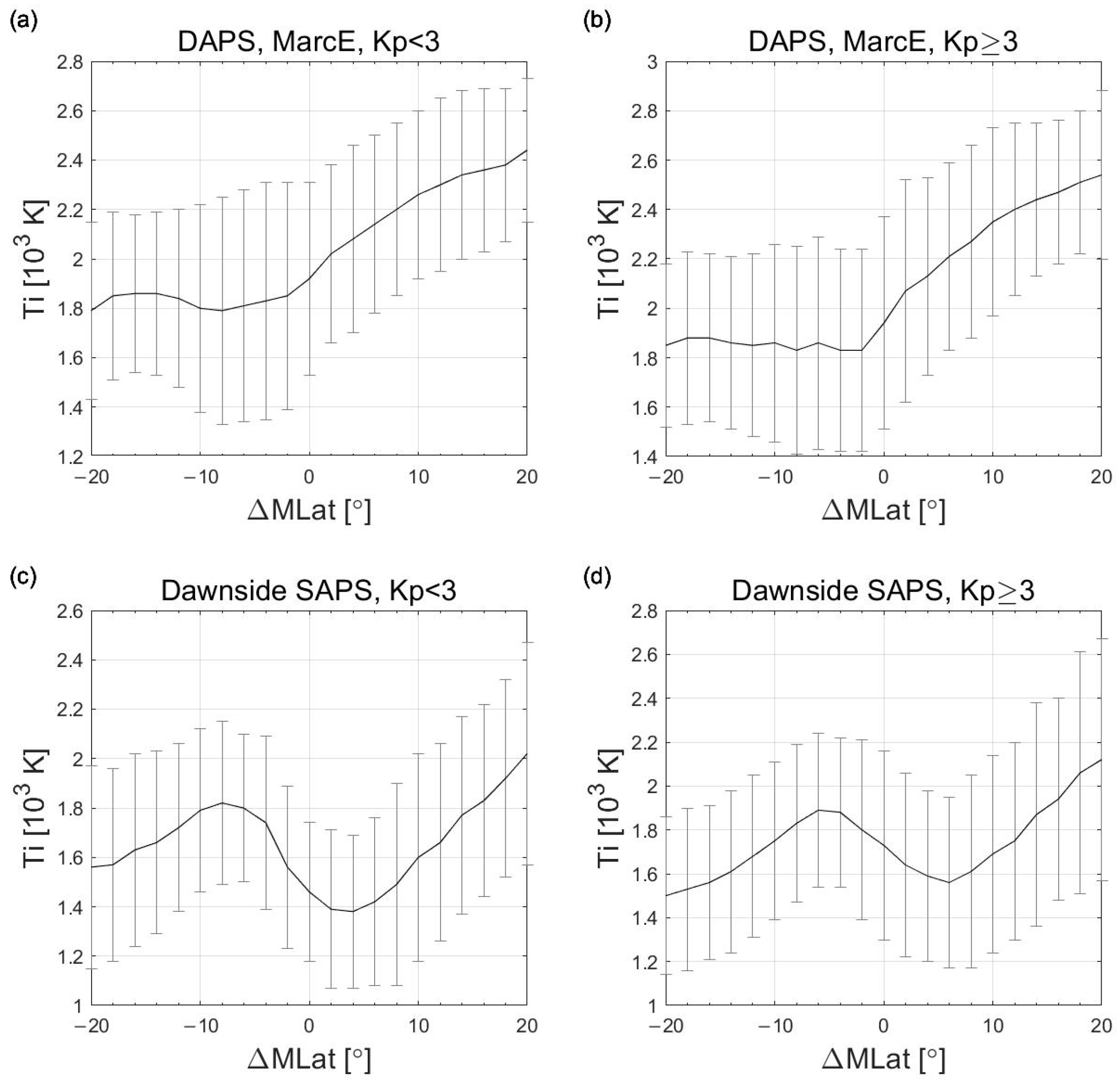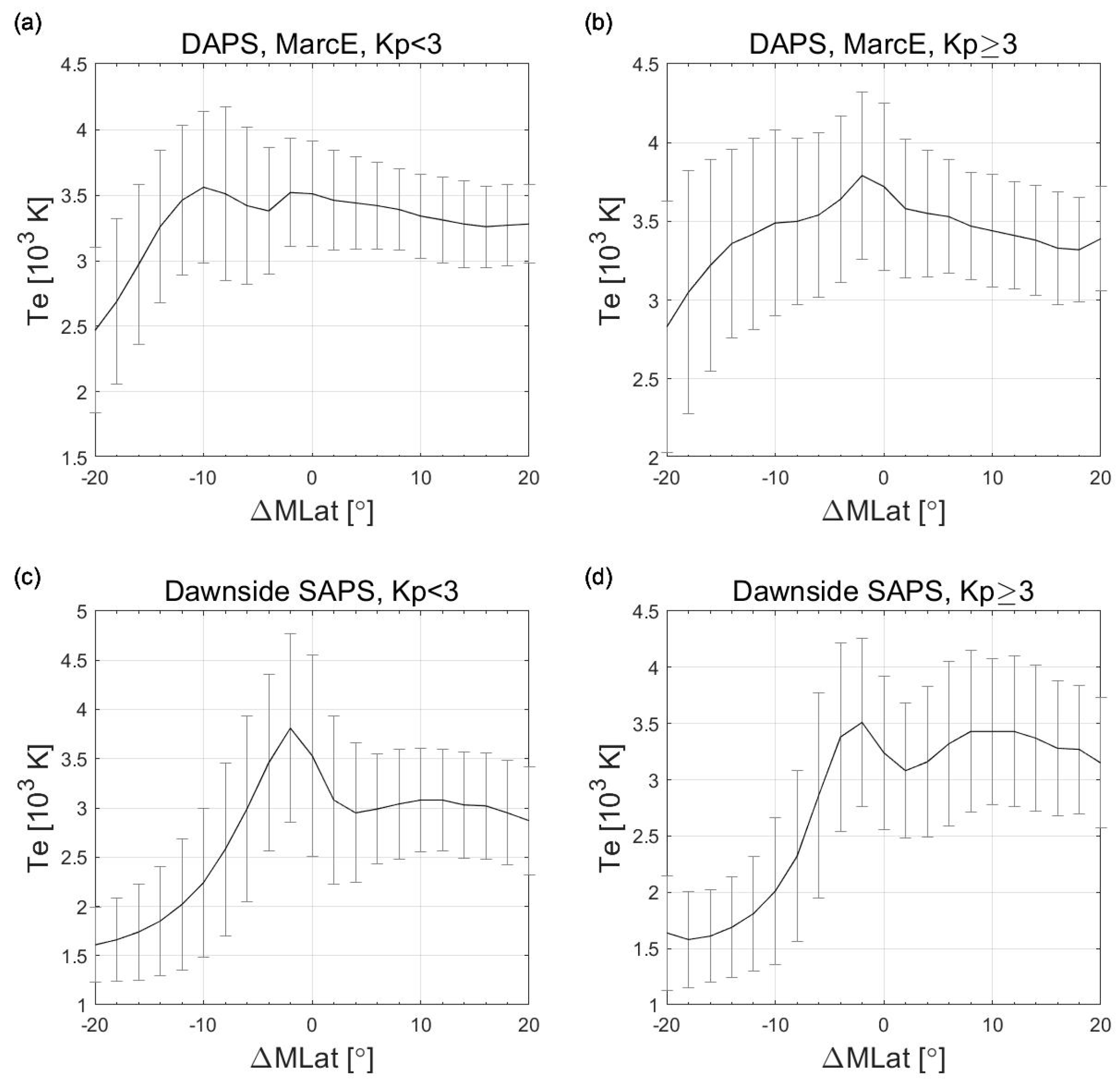A Statistical Study of Ion Upflow during Periods of Dawnside Auroral Polarization Streams and Subauroral Polarization Streams
Abstract
:1. Introduction
2. Dataset and Method of Statistical Analysis
3. Statistical Results
4. Discussion
4.1. Occurrence Rate
4.2. Upward Flow
4.3. Plasma Density
4.4. Plasma Temperature
5. Conclusions
- The occurrence rate of the dawnside SAPS is lower than those of both the DAPS and the duskside SAPS. Both the DAPS and SAPS show higher occurrence frequencies under increasing magnetic activity.
- The DAPS velocity is larger than the dawnside SAPS velocity at similar magnetic activity levels. Both zonal velocities are enhanced with increasing magnetic activities. There is a larger DAPS velocity in winter than in summer, similar to the duskside SAPS, which might be due to the relatively low solar illumination in winter.
- The ion upward flow peak around the DAPS shows similar seasonal and magnetic activity variations, indicating a close relationship with the DAPS. A large ion upflow flux can be found around the DAPS region, reaching 5.3 × 108 cm−2s−1 in the June solstice during highly disturbed periods.
- The peak upflow velocity around the dawnside SAPS weakens as the magnetic activity increases, indicating weaker ion-neutral collision heating under more-disturbed periods. There is no obviously enhanced ion upflow flux related to the dawnside SAPS due to the relatively deep midlatitude trough and weak upward velocity.
- The dawnside midlatitude trough is collocated with the SAPS, but its depth becomes shallower with increasing magnetic activity; this is in contrast to the SAPS effect on the duskside. There is a lack of any ion density peak or trough around the DAPS region at the DMSP altitude of ~800 km.
- Around the SAPS region, the ion temperature decreases due to adiabatic cooling in the upper ionosphere, while there is a negligible change around the DAPS region. For both the DAPS and SAPS, the elevated electron temperatures might be explained by heat conduction or Coulomb collisions.
Author Contributions
Funding
Data Availability Statement
Acknowledgments
Conflicts of Interest
References
- Foster, J.C.; Vo, H.B. Average characteristics and activity dependence of the subauroral polarization stream. J. Geophys. Res. Atmos. 2002, 107, SIA 16-1–SIA 16-10. [Google Scholar] [CrossRef] [Green Version]
- Spiro, R.W.; Heelis, R.A.; Hanson, W.B. Ion convection and the formation of the mid-latitude F region ionization trough. J. Geophys. Res. Space Phys. 1978, 83, 4255–4264. [Google Scholar] [CrossRef]
- Anderson, P.C.; Hanson, W.B.; Heelis, R.A.; Craven, J.D.; Baker, D.N.; Frank, L.A. A proposed production model of rapid subauroral ion drifts and their relationship to substorm evolution. J. Geophys. Res. Atmos. 1993, 98, 6069–6078. [Google Scholar] [CrossRef]
- Lejosne, S.; Kunduri, B.S.R.; Mozer, F.S.; Turner, D.L. Energetic Electron Injections Deep Into the Inner Magnetosphere: A Result of the Subauroral Polarization Stream (SAPS) Potential Drop. Geophys. Res. Lett. 2018, 45, 3811–3819. [Google Scholar] [CrossRef]
- Wang, Z.; Zou, S.; Shepherd, S.G.; Liang, J.; Gjerloev, J.W.; Ruohoniemi, J.M.; Wygant, J.R. Multi-instrument ob-servations of mesoscale enhancement of subauroral polarization stream associated with an injection. J. Geophys. Res. Space Phys. 2019, 124, 1770–1784. [Google Scholar] [CrossRef]
- Aa, E.; Erickson, P.J.; Zhang, S.; Zou, S.; Coster, A.J.; Goncharenko, L.P.; Foster, J.C. A Statistical Study of the Subauroral Polarization Stream Over North American Sector Using the Millstone Hill Incoherent Scatter Radar 1979–2019 Measurements. J. Geophys. Res. Space Phys. 2020, 125, e2020JA028584. [Google Scholar] [CrossRef]
- Wang, H.; Ridley, A.; Lühr, H.; Liemohn, M.; Ma, S.Y. Statistical study of the subauroral polarization stream: Its dependence on the cross-polar cap potential and subauroral conductance. J. Geophys. Res. Atmos. 2008, 113, A12311. [Google Scholar] [CrossRef] [Green Version]
- Erickson, P.J.; Beroz, F.; Miskin, M.Z. Statistical characterization of the American sector subauroral polarization stream using incoherent scatter radar. J. Geophys. Res. Atmos. 2011, 116, A00J21. [Google Scholar] [CrossRef] [Green Version]
- Kunduri, B.S.R.; Baker, J.B.H.; Ruohoniemi, J.M.; Clausen, L.B.N.; Grocott, A.; Thomas, E.G.; Freeman, M.P.; Talaat, E.R. An examination of inter-hemispheric conjugacy in a subauroral polarization stream. J. Geophys. Res. Atmos. 2012, 117, A08225. [Google Scholar] [CrossRef] [Green Version]
- Kunduri, B.S.R.; Baker, J.B.H.; Ruohoniemi, J.M.; Thomas, E.G.; Shepherd, S.G.; Sterne, K.T. Statistical charac-terization of the large-scale structure of the subauroral polarization stream. J. Geophys. Res. Space Phys. 2017, 122, 6035–6048. [Google Scholar] [CrossRef]
- Wang, W.; Talaat, E.R.; Burns, A.G.; Emery, B.; Hsieh, S.-Y.; Lei, J.; Xu, J. Thermosphere and ionosphere response to subauroral polarization streams (SAPS): Model simulations. J. Geophys. Res. Atmos. 2012, 117, A07301. [Google Scholar] [CrossRef] [Green Version]
- Wang, H.; Lühr, H.; Ma, S.Y. The relation between subauroral polarization streams, westward ion fluxes, and zonal wind: Seasonal and hemispheric variations. J. Geophys. Res. Atmos. 2012, 117, A04323. [Google Scholar] [CrossRef]
- Wang, H.; Lühr, H.; Ritter, P.; Kervalishvili, G. Temporal and spatial effects of subauroral polarization streams on the thermospheric dynamics. J. Geophys. Res. Atmos. 2012, 117, A11307. [Google Scholar] [CrossRef] [Green Version]
- Wang, H.; Zhang, K.; Zheng, Z.; Ridley, A.J. The effect of subauroral polarization streams on the mid-latitude thermospheric disturbance neutral winds: A universal time effect. Ann. Geophys. 2018, 36, 509–525. [Google Scholar] [CrossRef] [Green Version]
- He, F.; Zhang, X.; Wang, W.; Wan, W. Different Evolution Patterns of Subauroral Polarization Streams (SAPS) During Intense Storms and Quiet Time Substorms. Geophys. Res. Lett. 2017, 44, 10796–10804. [Google Scholar] [CrossRef]
- Zhang, K.; Wang, H.; Yamazaki, Y.; Xiong, C. Effects of Subauroral Polarization Streams on the Equatorial Electrojet During the Geomagnetic Storm on June 1, 2013. J. Geophys. Res. Space Phys. 2021, 126, e2021JA029681. [Google Scholar] [CrossRef]
- Zhang, K.; Wang, H.; Yamazaki, Y. Effects of Subauroral Polarization Streams on the Equatorial Electrojet During the Geomagnetic Storm on 1 June 2013: 2. The Temporal Variations. J. Geophys. Res. Space Phys. 2022, 127, e2021JA030180. [Google Scholar] [CrossRef]
- Zhang, K.; Wang, H.; Wang, W. Local Time Variations of the Equatorial Electrojet in Simultaneous Response to Subauroral Polarization Streams During Quiet Time. Geophys. Res. Lett. 2022, 49, e2022GL098623. [Google Scholar] [CrossRef]
- Mishin, E.V.; Burke, W.J.; Huang, C.Y.; Rich, F.J. Electromagnetic wave structures within subauroral polarization streams. J. Geophys. Res. Atmos. 2003, 108, 1309. [Google Scholar] [CrossRef]
- Mishin, E.V.; Burke, W.J. Stormtime coupling of the ring current, plasmasphere, and topside ionosphere: Electromagnetic and plasma disturbances. J. Geophys. Res. Atmos. 2005, 110, A07209. [Google Scholar] [CrossRef]
- He, F.; Zhang, X.-X.; Chen, B. Solar cycle, seasonal, and diurnal variations of subauroral ion drifts: Statistical results. J. Geophys. Res. Space Phys. 2014, 119, 5076–5086. [Google Scholar] [CrossRef]
- Wei, D.; Yu, Y.; Ridley, A.J.; Cao, J.; Dunlop, M.W. Multi-point observations and modeling of subauroral polarization streams (SAPS) and double-peak subauroral ion drifts (DSAIDs): A case study. Adv. Space Res. 2019, 63, 3522–3535. [Google Scholar] [CrossRef]
- Sinevich, A.A.; Chernyshov, A.A.; Chugunin, D.V.; Oinats, A.V.; Clausen, L.B.N.; Miloch, W.J.; Nishitani, N.; Mogilevsky, M.M. Small-Scale Irregularities Within Polarization Jet/SAID During Geomagnetic Activity. Geophys. Res. Lett. 2022, 49, e2021GL097107. [Google Scholar] [CrossRef] [PubMed]
- Horvath, I.; Lovell, B.C. Abnormal Subauroral Ion Drifts (ASAID) and Pi2s During Cross-Tail Current Disruptions Observed by Polar on the Magnetically Quiet Days of October 2003. J. Geophys. Res. Space Phys. 2019, 124, 6097–6116. [Google Scholar] [CrossRef] [Green Version]
- Yau, A.W.; Andre, M. Sources of Ion Outflow in the High Latitude Ionosphere. Space Sci. Rev. 1997, 80, 1–25. [Google Scholar] [CrossRef]
- Yeh, H.C.; Foster, J.C. Storm time heavy ion outflow at mid-latitude. J. Geophys. Res. Space Phys. 1990, 95, 7881–7891. [Google Scholar] [CrossRef]
- Anderson, P.C.; Heelis, R.A.; Hanson, W.B. The ionospheric signatures of rapid subauroral ion drifts. J. Geophys. Res. Atmos. 1991, 96, 5785–5792. [Google Scholar] [CrossRef]
- Heelis, R.A.; Bailey, G.J.; Sellek, R.; Moffett, R.J.; Jenkins, B. Field-Aligned Drifts in Subauroral Ion Drift Events. J. Geophys. Res. Atmos. 1993, 98, 21493–21499. [Google Scholar] [CrossRef]
- Erickson, P.; Goncharenko, L.; Nicolls, M.; Ruohoniemi, M.; Kelley, M. Dynamics of North American sector ionospheric and thermospheric response during the November 2004 superstorm. J. Atmos. Sol.-Terr. Phys. 2009, 72, 292–301. [Google Scholar] [CrossRef]
- Zhang, S.R.; Erickson, P.J.; Zhang, Y.; Wang, W.; Huang, C.; Coster, A.J.; Holt, J.M.; Foster, J.F.; Sulzer, M.; Kerr, R. Observations of ion-neutral coupling associated with strong electrodynamic disturbances during the 2015 St. Patrick’s Day storm. J. Geophys. Res. Space Phys. 2017, 122, 1314–1337. [Google Scholar] [CrossRef] [Green Version]
- Wang, H.; Lühr, H. Seasonal variation of the ion upflow in the topside ionosphere during SAPS (sub-auroral polarization stream) periods. Ann. Geophys. 2013, 9, 1521–1534. [Google Scholar] [CrossRef]
- Yau, A.W.; Shelley, E.G.; Peterson, W.K.; Lenchyshyn, L. Energetic auroral and polar ion outflow at DE 1 altitudes: Magnitude, composition, magnetic activity dependence, and long-term variations. J. Geophys. Res. Atmos. 1985, 90, 8417. [Google Scholar] [CrossRef]
- Khalipov, V.L.; Kotova, G.A.; Kobyakova, S.E.; Bogdanov, V.V.; Kaisin, A.B.; Panchenko, V.A.; Stepanov, A.E. Vertical plasma drift velocities in the polarization jet observation by ground Doppler measurements and driftmeters on DMSP satellites. Geomagn. Aeron. 2016, 56, 535–544. [Google Scholar] [CrossRef]
- Stepanov, A.E.; Khalipov, V.L.; Kobyakova, S.E.; Kotova, G.A. Results of Observations of Ionospheric Plasma Drift in the Polarization Jet Region. Geomagn. Aeron. 2019, 59, 539–542. [Google Scholar] [CrossRef]
- Zhang, Q.-H.; Liu, Y.C.; Xing, Z.; Wang, Y.; Ma, Y. Statistical Study of Ion Upflow Associated with Subauroral Polarization Streams (SAPS) at Substorm Time. J. Geophys. Res. Space Phys. 2020, 125, e2019JA027163. [Google Scholar] [CrossRef]
- Horvath, I.; Lovell, B.C. Investigating the Coupled Magnetosphere-Ionosphere-Thermosphere (M-I-T) System’s Responses to the 20 November 2003 Superstorm. J. Geophys. Res. Space Phys. 2021, 126, e2021JA029215. [Google Scholar] [CrossRef]
- Huang, C.; Zhang, Y.; Wang, W.; Lin, D.; Wu, Q. Low-Latitude Zonal Ion Drifts and Their Relationship With Subauroral Polarization Streams and Auroral Return Flows During Intense Magnetic Storms. J. Geophys. Res. Space Phys. 2021, 126, e2021JA030001. [Google Scholar] [CrossRef]
- Lin, D.; Wang, W.; Merkin, V.G.; Huang, C.; Oppenheim, M.; Sorathia, K.; Pham, K.; Michael, A.; Bao, S.; Wu, Q.; et al. Origin of Dawnside Subauroral Polarization Streams During Major Geomagnetic Storms. AGU Adv. 2022, 3, e2022AV000708. [Google Scholar] [CrossRef]
- Liu, J.; Lyons, L.R.; Wang, C.; Hairston, M.R.; Zhang, Y.; Zou, Y. Dawnside Auroral Polarization Streams. J. Geophys. Res. Space Phys. 2020, 125, e2019JA027742. [Google Scholar] [CrossRef]
- Seo, Y.; Horwitz, J.L.; Caton, R. Statistical relationships between high-latitude ionospheric F region/topside upflows and their drivers: DE 2 observations. J. Geophys. Res. Atmos. 1997, 102, 7493–7500. [Google Scholar] [CrossRef]
- Hardy, D.A.; Schmitt, L.K.; Gussenhoven, M.S.; Marshall, F.J.; Yeh, H.C. Precipitating Electron and Ion Detectors (SSJ/4) for the Block 5D/Flights 6-10 DMSP (Defense Meteorological Satellite Program) Satellites: Calibration and Data Presentation; Rep. AFGL-TR-84-0314; Air Force Geophys. Lab., Air Force Base: Fort Belvoir, VA, USA, 1984. [Google Scholar]
- Robinson, R.M.; Vondrak, R.R.; Miller, K.; Dabbs, T.; Hardy, D. On calculating ionospheric conductances from the flux and energy of precipitating electrons. J. Geophys. Res. Atmos. 1987, 92, 2565–2569. [Google Scholar] [CrossRef]
- Olifer, L.; Feltman, C.; Ghaffari, R.; Henderson, S.; Huyghebaert, D.; Burchill, J.; Jaynes, A.N.; Knudsen, D.; McWilliams, K.; Moen, J.I.; et al. Swarm Observations of Dawn/Dusk Asymmetries Between Pedersen Conductance in Upward and Downward Field-Aligned Current Regions. Earth Space Sci. 2021, 8, e2020EA001167. [Google Scholar] [CrossRef]
- Wang, H.; Lühr, H.; Ma, S.Y.; Weygand, J.; Skoug, R.M.; Yin, F. Field-aligned currents observed by CHAMP during the intense 2003 geomagnetic storm events. Ann. Geophys. 2006, 24, 311–324. [Google Scholar] [CrossRef] [Green Version]
- Hairston, M.R.; Rich, F.J.; Heelis, R.A. Analysis of the ionospheric cross polar cap potential drop using DMSP data during the National Space Weather Program study period. J. Geophys. Res. Atmos. 1998, 103, 26337–26347. [Google Scholar] [CrossRef]
- Liu, J.; Lyons, L.R.; Wang, C.; Ma, Y.; Strangeway, R.J.; Zhang, Y.; Kivelson, M.; Zou, Y.; Khurana, K. Embedded Regions 1 and 2 Field-Aligned Currents: Newly Recognized From Low-Altitude Spacecraft Observations. J. Geophys. Res. Space Phys. 2021, 126, e2021JA029207. [Google Scholar] [CrossRef]
- Anderson, P.C.; Carpenter, D.L.; Tsuruda, K.; Mukai, T.; Rich, F.J. Multisatellite observations of rapid subauroral ion drifts (SAID). J. Geophys. Res. Atmos. 2001, 106, 29585–29599. [Google Scholar] [CrossRef]
- Lühr, H.; Rentz, S.; Ritter, P.; Liu, H.; Häusler, K. Average thermospheric wind patterns over the polar regions, as observed by CHAMP. Ann. Geophys. 2007, 25, 1093–1101. [Google Scholar] [CrossRef] [Green Version]
- Huang, T.; Lühr, H.; Wang, H.; Xiong, C. The Relationship of High-Latitude Thermospheric Wind With Ionospheric Horizontal Current, as Observed by CHAMP Satellite. J. Geophys. Res. Space Phys. 2017, 122, 12378–12392. [Google Scholar] [CrossRef] [Green Version]
- Liu, Z.; Zong, Q. Ionospheric Oxygen Outflows Directly Injected Into the Inner Magnetosphere: Van Allen Probes Statistics. J. Geophys. Res. Space Phys. 2022, 127, e2022JA030611. [Google Scholar] [CrossRef]
- Zou, S.; Moldwin, M.B.; Nicolls, M.J.; Ridley, A.J.; Coster, A.J.; Yizengaw, E.; Lyons, L.R.; Donovan, E.F. Electrodynamics of the high-latitude trough: Its relationship with convection flows and field-aligned currents. J. Geophys. Res. Space Phys. 2013, 118, 2565–2572. [Google Scholar] [CrossRef] [Green Version]
- Wang, W.; Burns, A.G.; Killeen, T.L. A numerical study of the response of ionospheric electron temperature to geomagnetic activity. J. Geophys. Res. Atmos. 2006, 111, A11301. [Google Scholar] [CrossRef] [Green Version]
- Prölss, G.W. Subauroral electron temperature enhancement in the nighttime ionosphere. Ann. Geophys. 2006, 24, 1871–1885. [Google Scholar] [CrossRef] [Green Version]










| Dawnside SAPS | DAPS | |||||||
|---|---|---|---|---|---|---|---|---|
| Season | Kp < 3 | Kp ≥ 3 | Kp < 3 | Kp ≥ 3 | ||||
| Number of Events | Mean Kp | Number of Events | Mean Kp | Number of Events | Mean Kp | Number of Events | Mean Kp | |
| MarcE | 62 (3.2%) | 1.6 | 69 (13.3%) | 4.2 | 637 (33.1%) | 1.5 | 265 (51.0%) | 3.8 |
| JuneS | 7 (0.4%) | 1.9 | 16 (3.9%) | 4.8 | 597 (30.5%) | 1.4 | 208 (50.2%) | 3.9 |
| SeptE | 82 (4.7%) | 1.4 | 87 (15.0%) | 4.2 | 565 (32.5%) | 1.5 | 305 (52.4%) | 4.1 |
| DeceS | 78 (4.0%) | 1.6 | 43 (9.5%) | 3.8 | 721 (36.8%) | 1.4 | 228 (50.1%) | 3.6 |
| Eastward Velocity, Vy (m/s) | DAPS | Dawnside SAPS | |||
|---|---|---|---|---|---|
| Season | MarcE | JuneS | SeptE | DeceS | / |
| Kp < 3 | 536 | 541 | 724 | 717 | 268 |
| Kp ≥ 3 | 704 | 717 | 915 | 807 | 347 |
| Upward Velocity, Vz (m/s) | DAPS | Dawnside SAPS | |||
|---|---|---|---|---|---|
| Season | MarcE | JuneS | SeptE | DeceS | / |
| Kp < 3 | 185 | 168 | 273 | 218 | 167 |
| Kp ≥ 3 | 284 | 290 | 384 | 325 | 116 |
| Plasma Density, Ne (104/cm³) | DAPS | Dawnside SAPS | |||
|---|---|---|---|---|---|
| Season | MarcE | JuneS | SeptE | DeceS | / |
| Kp < 3 | 1.95 | 2.13 | 0.62 | 0.52 | 0.33 |
| Kp ≥ 3 | 1.96 | 1.98 | 0.91 | 0.78 | 0.84 |
| Upflow Flux (108 cm−2s−1) | DAPS | Dawnside SAPS | |||
|---|---|---|---|---|---|
| Season | MarcE | JuneS | SeptE | DeceS | / |
| Kp < 3 | 2.9 | 3.3 | 1.5 | 0.8 | 0.4 |
| Kp ≥ 3 | 5.1 | 5.3 | 3.6 | 2.3 | 0.7 |
Disclaimer/Publisher’s Note: The statements, opinions and data contained in all publications are solely those of the individual author(s) and contributor(s) and not of MDPI and/or the editor(s). MDPI and/or the editor(s) disclaim responsibility for any injury to people or property resulting from any ideas, methods, instructions or products referred to in the content. |
© 2023 by the authors. Licensee MDPI, Basel, Switzerland. This article is an open access article distributed under the terms and conditions of the Creative Commons Attribution (CC BY) license (https://creativecommons.org/licenses/by/4.0/).
Share and Cite
Qian, C.; Wang, H. A Statistical Study of Ion Upflow during Periods of Dawnside Auroral Polarization Streams and Subauroral Polarization Streams. Remote Sens. 2023, 15, 1320. https://doi.org/10.3390/rs15051320
Qian C, Wang H. A Statistical Study of Ion Upflow during Periods of Dawnside Auroral Polarization Streams and Subauroral Polarization Streams. Remote Sensing. 2023; 15(5):1320. https://doi.org/10.3390/rs15051320
Chicago/Turabian StyleQian, Chengyu, and Hui Wang. 2023. "A Statistical Study of Ion Upflow during Periods of Dawnside Auroral Polarization Streams and Subauroral Polarization Streams" Remote Sensing 15, no. 5: 1320. https://doi.org/10.3390/rs15051320





